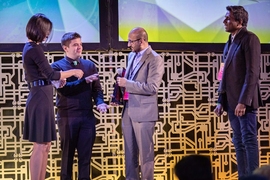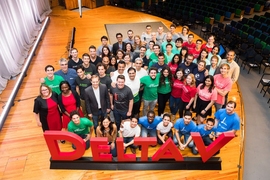It’s easy to make major changes to a startup in the early stages of its development. But when an entrepreneur has invested years into building a company, attracting employees and customers in the process, changing course can be a painful experience.
Sam Bhattacharyya learned that lesson firsthand in 2018, a year he calls the hardest of his life. Bhattacharyya is the CEO of Vectorly, a video compression company capable of reducing by tenfold the file size of geometric videos such as slide lectures, screencasts, and animations.
Vectorly is currently working with 12 companies in a pilot test and has processed over 2,000 videos using its vector graphics technology to date. By the end of 2019, the company hopes to be working with some of the largest video content providers in the world, saving them millions in cloud data costs and allowing them to increase their reach into emerging markets.
In many ways, Vectorly’s recent milestones are similar to those of most other successful startups. But the founders’ journey up to this point has been far more tumultuous: The once-heralded startup was reaching tens of thousands of people before its founders realized the path to scale could have it teetering on the edge of bankruptcy.
All of that drama, though, happened when Vectorly was a completely different company called dot Learn.
Passion and a vision
In 2015, Sam Bhattacharyya MBA ’16 and Tunde Alawode SM ’15 PhD ’17 decided to create a mobile learning app for students in Sub-Saharan Africa called dot Learn. Their ultimate goal was to make online learning accessible to 50 million students around the world by 2022.
It was an ambitious vision, but the two men fully committed themselves to it. They received grants from the MIT D-Lab, MISTI’s MIT-Africa Initiative, MIT Sandbox, and the Legatum Center for Development and Entrepreneurship. They also participated in programs like the MIT IDEAS Global Challenge, MIT delta v, and the MIT $100K pitch competition.
They used their numerous grants to spend summers and Independent Activities Periods in Ghana, where they learned that one of the biggest problems for students trying to watch educational videos on their phones was the high price of data.
Mulling over the problem in Ghana one day, Bhattacharyya had the epiphany to use vector graphics, a technique traditionally used to compress images, to shrink dot Learn’s video files. A few hours of coding later, and he had hacked together a prototype in his hotel room.
The founders launched their learning platform in Ghana just in time for the 2016 delta v program, gaining their first 500 users as dot Learn transitioned from a passion project to a business. A week after completing the program, Bhattacharyya moved to Ghana to help dot Learn scale.
Through a combination of hard work and ingenuity, Bhattacharyya and Alawode began to see their vision come to life. By the summer of 2017, the platform had 10,000 users across Ghana. The founders were hearing from the teachers they’d partnered with that it was the best job they’d ever had, and student engagement metrics were strong.
But things changed when they expanded to Nigeria. There, students largely rejected the platform, often entering the app and then quickly leaving. As the founders investigated the problem, they realized scaling through West Africa was going to be far more difficult than anticipated.
One problem was that students preparing for tests in Nigeria are more accustomed to taking practice exams rather than studying subjects generally. Another issue was the absence of mobile money in Nigeria — an essential piece of dot Learn’s business model.
“The main problem was that we didn’t appreciate the differences between Ghana and Nigeria,” Bhattacharyya says.
A difficult decision
As the founders came to terms with the poor numbers toward the end of 2017, they knew major changes had to be made. They could develop a new payment system and create all new courses that appealed to Nigerians, but Bhattacharyya estimated dot Learn only had the funding to operate for another 10 months, making such a large project a risky proposition. At the same time, another option seemed to be presenting itself.
Since dot Learn had debuted its video compression technology, other companies had asked about licensing it. Seeing it as a major differentiator for their app, the founders had mostly ignored the requests.
But as CEO, Bhattacharyya could now see that drastic changes were needed. Ultimately, he realized the only way to continue was to reinvent the company by closing down its West African office and focusing on the video compression technology. It was an excruciating decision that he knew preceded a long and difficult process.
First he had to inform his team members; Alawode and Bhattacharyya worked together to see dot Learn through the pivot, but most others were let go. Bhattacharyya says the hardest part of the process was telling the teachers from Ghana and Nigeria.
Bhattacharyya felt shame at not recognizing the problems with scaling at an earlier stage, and, personally, he had to reconcile his original mission with the new one.
“I’ve had the question in my mind, and people have asked me, ‘Isn’t [the change] taking away from your social mission?’ And for me, part of the reason for the pivot was precisely because I thought it was a better way to advance the social mission, by partnering with the big education technology companies,” Bhattacharyya says.
Bhattacharyya knew he needed to assemble a new team quickly to successfully reorient dot Learn as a business-to-business (B2B) tech company, which he renamed Vectorly. Relying heavily on LinkedIn, he reached out to hundreds of people between April and May of 2018, holding interviews spanning from 6 a.m. to 1 a.m. on some days because many of his new hires were in India.
It was also becoming increasingly clear that Vectorly would need to raise a small amount of money to give it enough time to get its compression technology ready for customers. He knew, however, that fundraising would be difficult without a demonstrable product, some early traction, or even an issued patent. (At the time, the company was still waiting on the U.S. Patent Office.)
Bhattacharyya worked frantically with his new team to set up pilots with some of the small education companies in emerging markets that had first reached out about licensing the technology from dot Learn. In August of 2018, they launched the first version of the video compression technology.
The turning point came in October, when Vectorly’s patent for turning video files into vector graphics files was issued. Then in November, Vectorly won first place at a startup pitch competition in New York, which attracted interest from dozens of early stage investors. He’s happy to report that he’s in the process of closing a preseed round now, something he doesn’t believe would have been possible without the patent.
It’s been an emotional journey for Bhattacharyya, who says he believes in the potential of the company’s technology, but admits he’s still grappling with the dramatic change to the business.
“I’m passionate about making educational videos more accessible in emerging markets, but as part of our pitch, we’ve had to explore the other things that this technology can do,” Bhattacharyya says. “When you pivot, you question yourself. What did I originally set out to do and what am I doing now? Are we on the same page? What’s the vision behind the company?”
Bhattacharyya, who also holds a bachelor’s degree in mechanical engineering from Columbia University and a master’s in robotics from Vanderbilt University, credits his experience taking business classes at MIT with helping him steer the company through the pivot.
“I’m still very much an engineer, but to be able to combine that with a business mindset, talking with customers and investors while working in the weeds with the engineers, I don’t think there’s a better place to build that skillset than MIT,” he says. “I have to be able to analyze computer vision Python code on Slack one minute, then talk to customers about product features and to investors about market sizing the next. That’s been my life, juggling those things, and all that was built at MIT.”
He also says the framework he learned at MIT for analyzing business opportunities is the only thing that kept him sane this past year, helping him break a seemingly overwhelming process down into simple steps.
Fortunately, it wasn’t all work for Bhattacharyya in 2018: He also got married. Now, with the pivot behind him, he feels the company is poised to maximize its impact.
“We decided this was a better way to go if we wanted to reach our initial goal of making online education more accessible to 50 million students around the developing world,” Bhattacharyya says. “Building a video learning app to do that is very difficult, but building a technology to work with other edtech companies makes it a lot more feasible to scale. If we can work with platforms like Coursera, edX, and Khan Academy, it’s a lot more feasible to make their content more accessible to users. What we’re doing now is very much connected to how we got started.”









